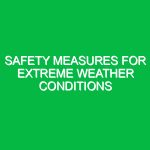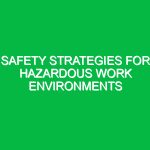In the construction industry, the importance of a robust Safety Management System (SMS) cannot be overstated. With its multifaceted nature, an SMS not only safeguards workers but also ensures project efficiency and compliance with health, safety, and environmental (HSE) regulations. As construction sites can be hazardous environments, understanding how to implement and maintain an effective Safety Management System is critical for professionals in this field.
Understanding Safety Management Systems for Construction Projects
At its core, a Safety Management System for Construction Projects is a structured approach designed to manage safety risks. It encompasses policies, procedures, and practices aimed at fostering a culture of safety. This system is crucial for preventing accidents, minimizing risks, and enhancing overall project performance.
Safety Management Systems guide organizations in identifying hazards, assessing risks, and implementing measures to mitigate them. They also facilitate compliance with local, national, and international safety regulations, ensuring that all stakeholders adhere to established standards. In an era where construction projects are becoming increasingly complex, an SMS serves as a foundational element in promoting a safe work environment.
Identifying Hazards and Risks in Construction Projects
Construction sites are riddled with potential hazards, making it essential to identify and evaluate risks systematically. Common hazards include:
1. Falls from Heights
Falls are among the leading causes of fatalities in construction. Workers may fall from ladders, scaffolding, or roofs. The risk increases if appropriate fall protection systems, such as guardrails or harnesses, are not in place.
2. Electrical Hazards
Live wires, improper grounding, and faulty equipment can lead to electrical shocks and fires. Workers must be trained to recognize these risks and utilize proper lockout/tagout procedures when working with electrical systems.
3. Machinery and Equipment Hazards
Heavy machinery, while essential for construction, can pose significant risks. Operators must be adequately trained, and equipment should undergo regular maintenance to prevent malfunctions that could result in accidents.
4. Hazardous Materials
Construction often involves handling substances like asbestos, lead, or chemicals. These materials can cause serious health issues if not managed correctly. Proper training on handling and disposal is vital.
5. Site Conditions
Uneven terrain, wet surfaces, and cluttered workspaces can lead to slips, trips, and falls. Conducting regular site assessments can help identify and rectify these hazards early.
Implementing Safety Precautions and Best Practices
Once hazards are identified, the next step is implementing safety precautions and best practices tailored to the specific risks present on a construction site. Here are some actionable strategies:
1. Training and Education
Training is the bedrock of an effective SMS. Workers should receive comprehensive training on safety protocols, hazard recognition, and emergency response. For instance, a construction company in Texas reported a significant decrease in accidents after instituting a rigorous training program for new hires. Programs should be updated regularly to incorporate new regulations and technologies.
2. Regular Safety Audits
Conducting routine safety audits can help identify potential hazards before they lead to incidents. These audits should assess not only compliance with safety regulations but also the effectiveness of existing safety measures. A construction firm in New York implemented monthly safety audits and noted a 30% reduction in workplace injuries within a year.
3. Effective Communication
Open lines of communication among all project stakeholders, including management, workers, and subcontractors, are crucial. Regular safety meetings can encourage discussion about potential hazards and promote a culture of safety. Creating an environment where employees feel comfortable reporting unsafe conditions can lead to quicker resolutions.
4. Personal Protective Equipment (PPE)
Providing appropriate PPE is essential in mitigating risks. Hard hats, gloves, eye protection, and high-visibility clothing should be mandatory on construction sites. For instance, a construction site in Florida saw a 25% decrease in injuries when they enforced stricter PPE policies.
5. Emergency Preparedness
Developing and communicating an emergency response plan is critical. This plan should outline procedures for various scenarios, including fires, medical emergencies, and natural disasters. Regular drills can ensure that all workers know their roles during an emergency.
Regulations and Standards Governing Safety Management Systems
Several regulations and standards govern Safety Management Systems for Construction Projects, ensuring compliance and promoting safety. Key regulations include:
1. OSHA Standards
The Occupational Safety and Health Administration (OSHA) sets forth regulations that govern workplace safety in the United States. Compliance with OSHA standards is mandatory for construction companies, covering everything from scaffolding safety to fall protection. Failure to comply can result in severe penalties.
2. ISO 45001
ISO 45001 is an international standard focused on occupational health and safety management systems. It provides a framework for organizations to improve employee safety, reduce workplace risks, and create better, safer working conditions. Many construction companies are adopting this standard to enhance their safety management practices.
3. Local Regulations
In addition to national standards, many states and municipalities have their own safety regulations that may be stricter than federal guidelines. It’s crucial for construction firms to be aware of and comply with these local laws to avoid fines and ensure worker safety.
Conclusion
In conclusion, an effective Safety Management System for Construction Projects is indispensable in today’s safety-conscious environment. By systematically identifying and mitigating hazards, implementing best practices, and adhering to regulatory standards, construction companies can create safer work environments for their employees. The integration of comprehensive training, regular audits, and effective communication fosters a culture of safety that not only protects workers but also enhances project efficiency and success.
As the industry evolves, the importance of a robust SMS will only increase. Companies that prioritize safety will not only comply with legal requirements but also build a reputation for reliability and care that can lead to long-term success.


